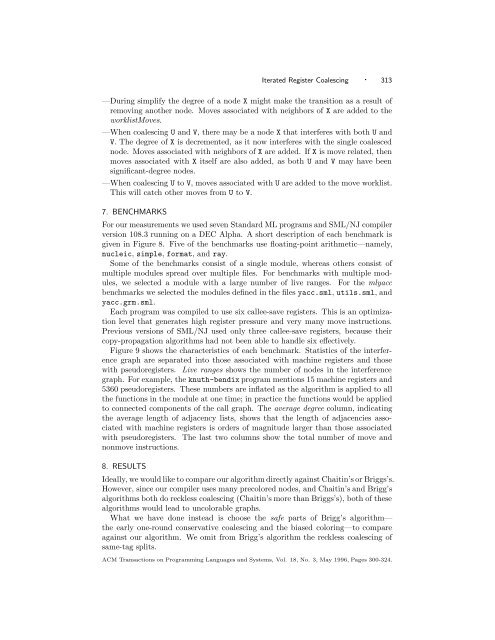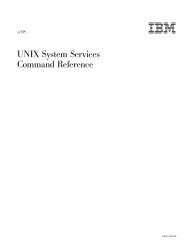Iterated Register Coalescing - School of Computer Science
Iterated Register Coalescing - School of Computer Science
Iterated Register Coalescing - School of Computer Science
Create successful ePaper yourself
Turn your PDF publications into a flip-book with our unique Google optimized e-Paper software.
<strong>Iterated</strong> <strong>Register</strong> <strong>Coalescing</strong> · 313—During simplify the degree <strong>of</strong> a node X might make the transition as a result <strong>of</strong>removing another node. Moves associated with neighbors <strong>of</strong> X are added to theworklistMoves.—When coalescing U and V, there may be a node X that interferes with both U andV. The degree <strong>of</strong> X is decremented, as it now interferes with the single coalescednode. Moves associated with neighbors <strong>of</strong> X are added. If X is move related, thenmoves associated with X itself are also added, as both U and V may have beensignificant-degree nodes.—When coalescing U to V, moves associated with U are added to the move worklist.This will catch other moves from U to V.7. BENCHMARKSFor our measurements we used seven Standard ML programs and SML/NJ compilerversion 108.3 running on a DEC Alpha. A short description <strong>of</strong> each benchmark isgiven in Figure 8. Five <strong>of</strong> the benchmarks use floating-point arithmetic—namely,nucleic, simple, format, andray.Some <strong>of</strong> the benchmarks consist <strong>of</strong> a single module, whereas others consist <strong>of</strong>multiple modules spread over multiple files. For benchmarks with multiple modules,we selected a module with a large number <strong>of</strong> live ranges. For the mlyaccbenchmarks we selected the modules defined in the files yacc.sml, utils.sml, andyacc.grm.sml.Each program was compiled to use six callee-save registers. This is an optimizationlevel that generates high register pressure and very many move instructions.Previous versions <strong>of</strong> SML/NJ used only three callee-save registers, because theircopy-propagation algorithms had not been able to handle six effectively.Figure 9 shows the characteristics <strong>of</strong> each benchmark. Statistics <strong>of</strong> the interferencegraph are separated into those associated with machine registers and thosewith pseudoregisters. Live ranges shows the number <strong>of</strong> nodes in the interferencegraph. For example, the knuth-bendix program mentions 15 machine registers and5360 pseudoregisters. These numbers are inflated as the algorithm is applied to allthe functions in the module at one time; in practice the functions would be appliedto connected components <strong>of</strong> the call graph. The average degree column, indicatingthe average length <strong>of</strong> adjacency lists, shows that the length <strong>of</strong> adjacencies associatedwith machine registers is orders <strong>of</strong> magnitude larger than those associatedwith pseudoregisters. The last two columns show the total number <strong>of</strong> move andnonmove instructions.8. RESULTSIdeally, we would like to compare our algorithm directly against Chaitin’s or Briggs’s.However, since our compiler uses many precolored nodes, and Chaitin’s and Brigg’salgorithms both do reckless coalescing (Chaitin’s more than Briggs’s), both <strong>of</strong> thesealgorithms would lead to uncolorable graphs.What we have done instead is choose the safe parts <strong>of</strong> Brigg’s algorithm—the early one-round conservative coalescing and the biased coloring—to compareagainst our algorithm. We omit from Brigg’s algorithm the reckless coalescing <strong>of</strong>same-tag splits.ACM Transactions on Programming Languages and Systems, Vol. 18, No. 3, May 1996, Pages 300-324.









